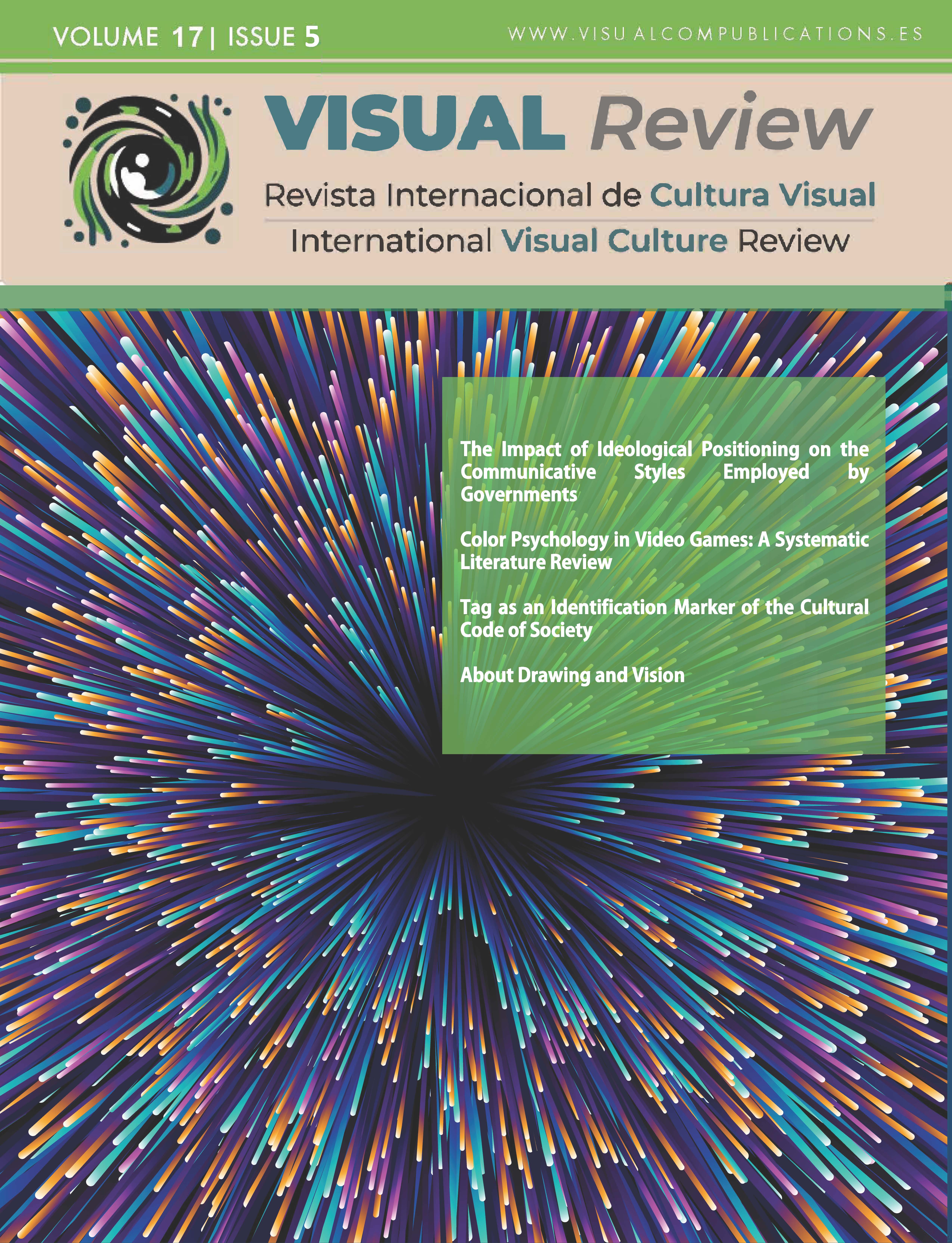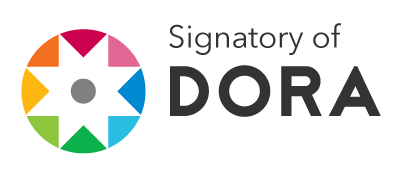Tag as an Identification Marker of the Cultural Code of Society
DOI:
https://doi.org/10.62161/revvisual.v17.5774Keywords:
tag, identification marker, graffiti, sign, cultural code, street art, font form, visual environmentAbstract
The article explores the tag as an identification marker of the cultural code of society, as well as the formation of the author's self-identification in the visual environment of the modern city. This study focused on analysing the visual series of tagging marks by studying the urban environment. The results demonstrate that tags are more than just visual elements - they perform multidimensional functions, combining street aesthetics, communication and social interaction. The study also highlights how visual symbols interact with the cultural and social aspects of urban digital spaces. The findings not only broaden the understanding of the concept of ‘tag’ but also open up new possibilities for researching its role in shaping contemporary visual art. The results of this study are of practical importance for both practitioners and scholars seeking to enrich the socio-cultural context of the contemporary visual environment.
Downloads
Global Statistics ℹ️
|
163
Views
|
56
Downloads
|
|
219
Total
|
|
References
Abdinabi, A., & Rayhona, T. (2024). Specific characteristics of the foundations of artistic creativity in the types and genres of fine art. Web of Teachers: Inderscience Research, 2(3), 219–228. https://webofjournals.com/index.php/1/article/view/1017
Achlioptas, P., Ovsjanikov, M., Haydarov, K., Elhoseiny, M., & Guibas, L. J. (2021). ArtEmis: An affective language for visual art. In Proceedings of the IEEE/CVF Conference on Computer Vision and Pattern Recognition (pp. 11569–11579). https://openaccess.thecvf.com/content/CVPR2021/html/Achlioptas_ArtEmis_Affective_Language_for_Visual_Art_CVPR_2021_paper.html DOI: https://doi.org/10.1109/CVPR46437.2021.01140
Aghajari, Z., Baumer, E. P., & DiFranzo, D. (2023). Reviewing interventions to address misinformation: The need to expand our vision beyond an individualistic focus. Proceedings of the ACM on Human-Computer Interaction, 7(CSCW1), 1–34. https://doi.org/10.1145/3579520 DOI: https://doi.org/10.1145/3579520
Ajzen, M., & Taskin, L. (2021). The re-regulation of working communities and relationships in the context of flexwork: A spacing identity approach. Information and Organisation, 31(4), 100364. https://doi.org/10.1016/j.infoandorg.2021.100364 DOI: https://doi.org/10.1016/j.infoandorg.2021.100364
Baldini, A. L. (2022). What is street art? Estetika: The European Journal of Aesthetics, 59(1), 1–21. https://www.ceeol.com/search/article-detail?id=1101587 DOI: https://doi.org/10.33134/eeja.234
Bengamra, S., Mzoughi, O., Bigand, A., & Zagrouba, E. (2024). A comprehensive survey on object detection in visual art: Taxonomy and challenge. Multimedia Tools and Applications, 83(5), 14637–14670. https://link.springer.com/article/10.1007/s11042-023-15968-9 DOI: https://doi.org/10.1007/s11042-023-15968-9
Biljecki, F., & Ito, K. (2021). Street view imagery in urban analytics and GIS: A review. Landscape and Urban Planning, 215, 104217. https://doi.org/10.1016/j.landurbplan.2021.104217 DOI: https://doi.org/10.1016/j.landurbplan.2021.104217
Bonadio, E. (2022). Preservation and heritagisation of street art and graffiti. In Research Handbook on Intellectual Property and Cultural Heritage (pp. 170–190). Edward Elgar Publishing. https://doi.org/10.4337/9781800376915.00017 DOI: https://doi.org/10.4337/9781800376915/book-part-9781800376915-17
Brown, D. K., & Mourão, R. R. (2021). Protest coverage matters: How media framing and visual communication affects support for Black civil rights protests. Mass Communication and Society, 24(4), 576–596. https://doi.org/10.1080/15205436.2021.1884724 DOI: https://doi.org/10.1080/15205436.2021.1884724
Campos, R., Pavoni, A., & Zaimakis, Y. (2021). Political graffiti in critical times: The aesthetics of street politics. Berghahn Books. https://www.torrossa.com/it/resources/an/5819096 DOI: https://doi.org/10.2307/j.ctv2tsxk6z
Carrington, Y. L. (2022). The semiotics of graffiti. IOSR Journal of Humanities and Social Science, 27, 12. http://surl.li/hewfhm
Dehouche, N., & Dehouche, K. (2023). What's in a text-to-image prompt? The potential of stable diffusion in visual arts education. Heliyon, 9(6). https://doi.org/10.1016/j.heliyon.2023.e16757 DOI: https://doi.org/10.1016/j.heliyon.2023.e16757
Denton, R., Díaz, M., Kivlichan, I., Prabhakaran, V., & Rosen, R. (2021). Whose ground truth? Accounting for individual and collective identities underlying dataset annotation. arXiv preprint arXiv:2112.04554. https://doi.org/10.48550/arXiv.2112.04554
Díaz, M., Kivlichan, I., Rosen, R., Baker, D., Amironesei, R., Prabhakaran, V., & Denton, E. (2022, June). Crowdworksheets: Accounting for individual and collective identities underlying crowdsourced dataset annotation. In Proceedings of the 2022 ACM Conference on Fairness, Accountability, and Transparency (pp. 2342–2351). https://doi.org/10.1145/3531146.3534647 DOI: https://doi.org/10.1145/3531146.3534647
Drijvers, L., Jensen, O., & Spaak, E. (2021). Rapid invisible frequency tagging reveals nonlinear integration of auditory and visual information. Human Brain Mapping, 42(4), 1138–1152. https://doi.org/10.1002/hbm.25282 DOI: https://doi.org/10.1002/hbm.25282
Elharrouss, O., Almaadeed, N., & Al-Maadeed, S. (2021). A review of video surveillance systems. Journal of Visual Communication and Image Representation, 77, 103116. https://doi.org/10.1016/j.jvcir.2021.103116 DOI: https://doi.org/10.1016/j.jvcir.2021.103116
Fairchild, N., Taylor, C. A., Carey, N., Koro, M., Benozzo, A., Hannes, K., ... & Taylor, A. J. (2024). Tags, tagging, tagged, #-undisciplining organ-isation of [academic] bodies. Culture and Organisation, 30(3), 263–289. https://doi.org/10.1080/14759551.2023.2193406 DOI: https://doi.org/10.1080/14759551.2023.2193406
Fan, Y. (2022). Analysing the semiotic nature of GIFs: Visual nominalisation and visual telicity. Language and Semiotic Studies, 8(3), 45–65. https://doi.org/10.1515/lass-2022-2004 DOI: https://doi.org/10.1515/lass-2022-2004
Figueira, J. S. B., Kutlu, E., Scott, L. S., & Keil, A. (2022). The FreqTag toolbox: A principled approach to analysing electrophysiological time series in frequency tagging paradigms. Developmental Cognitive Neuroscience, 54, 101066. https://doi.org/10.1016/j.dcn.2022.101066 DOI: https://doi.org/10.1016/j.dcn.2022.101066
Fransberg, M., Myllylä, M., & Tolonen, J. (2023). Embodied graffiti and street art research. Qualitative Research, 23(2), 362–379. https://doi.org/10.1177/14687941211028795 DOI: https://doi.org/10.1177/14687941211028795
Giari, G., Vignali, L., Xu, Y., & Bottini, R. (2023). MEG frequency tagging reveals a grid-like code during attentional movements. Cell Reports, 42(10). https://doi.org/10.1016/j.celrep.2023.113209 DOI: https://doi.org/10.1016/j.celrep.2023.113209
Goel, S., & Kumar, R. (2021). Collaboratively augmented UIP-filtered RIP with relevance mapping for personalisation of web search. Information Sciences, 547, 163–186. https://doi.org/10.1016/j.ins.2020.08.001 DOI: https://doi.org/10.1016/j.ins.2020.08.001
Gwilt, I., & Wilde, J. (2022). Augmented reality graffiti and street art. In Augmented Reality Art: From an Emerging Technology to a Novel Creative Medium (pp. 283–295). Cham: Springer International Publishing. https://doi.org/10.1007/978-3-030-96863-2_15 DOI: https://doi.org/10.1007/978-3-030-96863-2_15
Hada, N., Singh, A., & Vemuri, K. (2024). FolkTalent: Enhancing classification and tagging of Indian folk paintings. arXiv preprint arXiv:2405.08776. https://doi.org/10.48550/arXiv.2405.08776
Ho, R., Szubielska, M., & Kopiś-Posiej, N. (2023). Cultural-match effect on the appreciation of traditional and contemporary visual arts: Evidence from Poland and Hong Kong. Psychology of Aesthetics, Creativity, and the Arts, 17(4), 451. https://psycnet.apa.org/doi/10.1037/aca0000535 DOI: https://doi.org/10.1037/aca0000535
La Rocca, G., & Boccia Artieri, G. (2022). Research using hashtags: A meta-synthesis. Frontiers in Sociology, 7. https://doi.org/10.3389/fsoc.2022.1081603 DOI: https://doi.org/10.3389/fsoc.2022.1081603
Lan, X., Wu, Y., & Cao, N. (2024). Affective visualisation design: Leveraging the emotional impact of data. IEEE Transactions on Visualisation and Computer Graphics, 30(1), 1–11. https://doi.org/10.1109/TVCG.2023.3327385 DOI: https://doi.org/10.1109/TVCG.2023.3327385
Liu, D., & Yao, H. (2024). Artistic image synthesis with tag-guided correlation matching. Multimedia Tools and Applications, 83(2), 6413–6424. https://doi.org/10.1007/s11042-023-15182-7 DOI: https://doi.org/10.1007/s11042-023-15182-7
Lojdova, K. (2024). "We're the ones who didn't get spat out": Collective identity among private alternative teachers. Authorea Preprints. https://advance.sagepub.com/doi/full/10.31124/advance.24927135.v1 DOI: https://doi.org/10.31124/advance.24927135.v1
Manik, S., Tampubolon, S., & Padang, I. (2022). A semiotic pragmatic analysis of signs on billboard advertisement. Jurnal Scientia, 11(1), 367–368. https://doi.org/10.58471/scientia.v11i01.521 DOI: https://doi.org/10.58471/scientia.v11i01.521
Martínez-Carazo, E. M., Santamarina-Campos, V., & De-Miguel-Molina, M. (2021). The new emerging artistic expressions: Public mural art, graffiti and post-graffiti. In Cultural and creative mural spaces: Community, culture and tourism of Uruguayan contemporary muralism and other international mural spaces (pp. 113–130). https://doi.org/10.1007/978-3-030-53106-5_8 DOI: https://doi.org/10.1007/978-3-030-53106-5_8
Mattei, E. (2023). Theory and method for the statistical investigation of multimodal promotional practices in the digital era: A data-driven approach based on systemic functional linguistics and social semiotics. IDEAH, 3(2). https://doi.org/10.21428/f1f23564.7921b725 DOI: https://doi.org/10.21428/f1f23564.7921b725
Meier, M. L., & Sharp, K. (2024). Death to Chad and Stacy: Incels and anti-fandom as group identity. International Journal of Cultural Studies, 27(3), 349–367. https://doi.org/10.1177/13678779231220056 DOI: https://doi.org/10.1177/13678779231220056
Minarik, T., Berger, B., & Jensen, O. (2023). Optimal parameters for rapid (invisible) frequency tagging using MEG. NeuroImage, 281, 120389. https://doi.org/10.1016/j.neuroimage.2023.120389 DOI: https://doi.org/10.1016/j.neuroimage.2023.120389
Muratbekova, M., & Shamoi, P. (2024). Colour-emotion associations in art: A fuzzy approach. IEEE Access, 12, 37937–37956. https://doi.org/10.1109/ACCESS.2024.3375361 DOI: https://doi.org/10.1109/ACCESS.2024.3375361
Murray, C. A., Tarlow, M., Rissman, J., & Shams, L. (2022). Multisensory encoding of names via name tags facilitates remembering. Applied Cognitive Psychology, 36(6), 1277–1291. https://doi.org/10.1002/acp.4012 DOI: https://doi.org/10.1002/acp.4012
Myllylä, M., & Tolonen, J. (2023). Graffiti and street art research: An outsider perspective. Nuart Journal, 4(1), 111–115. https://nuartjournal.com/pdf/issue-7/12_NJ7-Myllyla.pdf
Petitimbert, J. P. (2024). Commercial semiotics: The structuralist (vs culturalist) perspective. Revista Acta Semiotica, 185–189. https://doi.org/10.23925/2763-700X.2024n7.67364 DOI: https://doi.org/10.23925/2763-700X.2024n7.67364
Peykarjou, S. (2022). Frequency tagging with infants: The visual oddball paradigm. Frontiers in Psychology, 13, 1015611. https://doi.org/10.3389/fpsyg.2022.1015611 DOI: https://doi.org/10.3389/fpsyg.2022.1015611
Poppi, F. I. M., & Copes, H. (2024). Identitas per fabulam: Joint fantasising in the construction of criminal group identities. Critical Criminology, 1–22. https://doi.org/10.1007/s10612-024-09760-w DOI: https://doi.org/10.1007/s10612-024-09760-w
Qin, C., Liu, Y., Ma, X., Chen, J., & Liang, H. (2022). Designing for serendipity in online knowledge communities: An investigation of tag presentation formats and openness to experience. Journal of the Association for Information Science and Technology, 73(10), 1401–1417. https://doi.org/10.1002/asi.24640 DOI: https://doi.org/10.1002/asi.24640
Rittershaus, L., & Eschenberg, K. (2021). Black Death, plagues, and the danse macabre: Depictions of epidemics in art. Historical Social Research/Historische Sozialforschung. Supplement (33), 330–341. https://www.jstor.org/stable/27087287
Shahriar, S. (2022). GAN computers generate arts? A survey on visual arts, music, and literary text generation using generative adversarial network. Displays, 73, 102237. https://doi.org/10.1016/j.displa.2022.102237 DOI: https://doi.org/10.1016/j.displa.2022.102237
Smets, K., & Ahenkona, L. (2024). Counter-documentation tactics: Participatory, visual, and walking research with undocumented migrants. Communication, Culture & Critique, 17(1), 24–31. https://doi.org/10.1093/ccc/tcad031 DOI: https://doi.org/10.1093/ccc/tcad031
Van Hoof, J., Marston, H. R., Kazak, J. K., & Buffel, T. (2021). Ten questions concerning age-friendly cities and communities and the built environment. Building and Environment, 199, 107922. https://doi.org/10.1016/j.buildenv.2021.107922 DOI: https://doi.org/10.1016/j.buildenv.2021.107922
Van Wichelen, T., De Loose, E., Dhoest, A., & De Ridder, S. (2024). From #AltErLove to #LoveIsLove: Transmedia formats, audience engagement and sexual diversity. Critical Studies in Television. https://doi.org/10.1177/17496020241247111 DOI: https://doi.org/10.1177/17496020241247111
Wang, X., Li, J., & Rajtmajer, S. (2024, May). Inside the echo chamber: Linguistic underpinnings of misinformation on Twitter. In Proceedings of the 16th ACM Web Science Conference (pp. 31–41). https://doi.org/10.1145/3614419.3644009 DOI: https://doi.org/10.1145/3614419.3644009
Wang, Y., Zhao, J. W., Zheng, M. Y., Li, M. Y., Sun, X., Liu, H., & Liu, Z. (2024). Applications of a deep neural network to illustration art style design of city architectural. Journal of Information Processing Systems, 20(1). https://koreascience.kr/article/JAKO202410243633577.pdf
Yang, N., Wu, G., MacEachren, A. M., Pang, X., & Fang, H. (2023). Comparison of font size and background colour strategies for tag weights on tag maps. Cartography and Geographic Information Science, 50(2), 162–177. https://doi.org/10.1080/15230406.2022.2152098 DOI: https://doi.org/10.1080/15230406.2022.2152098
Yates, S. (2024). Love Is Love Is Love: Broadway Musicals and LGBTQ Politics, 2010–2020 by Aaron C. Thomas. Theatre Topics, 34(2), 191–192. https://doi.org/10.1353/tt.2024.a932218 DOI: https://doi.org/10.1353/tt.2024.a932218
Zainubi, H. H., & Ciptadi, S. G. (2024). Environmental activism through Instagram: A study of the global climate strike campaign by Greenpeace Indonesia. International Journal of Environmental Communication (ENVICOMM), 2(2), 68–78. https://doi.org/10.35814/envicomm%20.v2i2.8029
Downloads
Published
How to Cite
Issue
Section
License
Copyright (c) 2025 Authors retain copyright and transfer to the journal the right of first publication and publishing rights

This work is licensed under a Creative Commons Attribution-NoDerivatives 4.0 International License.
Those authors who publish in this journal accept the following terms:
-
Authors retain copyright.
-
Authors transfer to the journal the right of first publication. The journal also owns the publishing rights.
-
All published contents are governed by an Attribution-NoDerivatives 4.0 International License.
Access the informative version and legal text of the license. By virtue of this, third parties are allowed to use what is published as long as they mention the authorship of the work and the first publication in this journal. If you transform the material, you may not distribute the modified work. -
Authors may make other independent and additional contractual arrangements for non-exclusive distribution of the version of the article published in this journal (e.g., inclusion in an institutional repository or publication in a book) as long as they clearly indicate that the work was first published in this journal.
- Authors are allowed and recommended to publish their work on the Internet (for example on institutional and personal websites), following the publication of, and referencing the journal, as this could lead to constructive exchanges and a more extensive and quick circulation of published works (see The Effect of Open Access).













